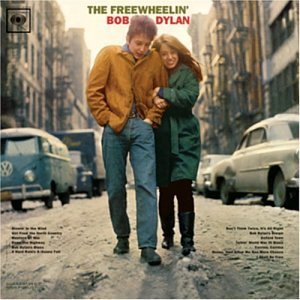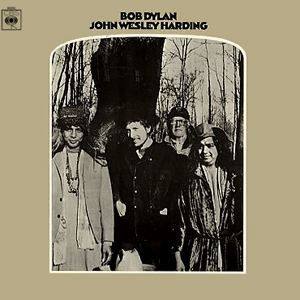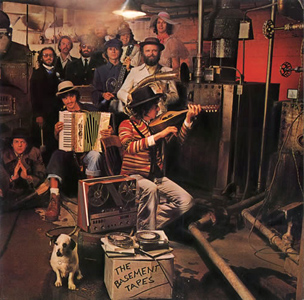Related Research Articles

Highway 61 Revisited is the sixth studio album by American singer-songwriter Bob Dylan, released on August 30, 1965, by Columbia Records. Having until then recorded mostly acoustic music, Dylan used rock musicians as his backing band on every track of the album, except for the closing track, the 11-minute ballad "Desolation Row". Critics have focused on the innovative way Dylan combined driving, blues-based music with the subtlety of poetry to create songs that captured the political and cultural chaos of contemporary America. Author Michael Gray has argued that, in an important sense, the 1960s "started" with this album.
"Desolation Row" is a 1965 song by the American singer-songwriter Bob Dylan. It was recorded on August 4, 1965, and released as the closing track of Dylan's sixth studio album, Highway 61 Revisited. It has been noted for its length (11:21) and surreal lyrics in which Dylan weaves characters into a series of vignettes that suggest entropy and urban chaos.

Blonde on Blonde is the seventh studio album by American singer-songwriter Bob Dylan, released as a double album on June 20, 1966 by Columbia Records. Recording sessions began in New York in October 1965 with numerous backing musicians, including members of Dylan's live backing band, the Hawks. Though sessions continued until January 1966, they yielded only one track that made it onto the final album—"One of Us Must Know ". At producer Bob Johnston's suggestion, Dylan, keyboardist Al Kooper, and guitarist Robbie Robertson moved to the CBS studios in Nashville, Tennessee. These sessions, augmented by some of Nashville's top session musicians, were more fruitful, and in February and March all the remaining songs for the album were recorded.

The Freewheelin' Bob Dylan is the second studio album by American singer-songwriter Bob Dylan, released on May 27, 1963 by Columbia Records. Whereas his self-titled debut album Bob Dylan had contained only two original songs, this album represented the beginning of Dylan's writing contemporary words to traditional melodies. Eleven of the thirteen songs on the album are Dylan's original compositions. It opens with "Blowin' in the Wind", which became an anthem of the 1960s, and an international hit for folk trio Peter, Paul and Mary soon after the release of the album. The album featured several other songs which came to be regarded as among Dylan's best compositions and classics of the 1960s folk scene: "Girl from the North Country", "Masters of War", "A Hard Rain's a-Gonna Fall" and "Don't Think Twice, It's All Right".

"All Along the Watchtower" is a song written and recorded by American singer-songwriter Bob Dylan. The song initially appeared on his 1967 album, John Wesley Harding, and it has been included on most of Dylan's subsequent greatest hits compilations. Since the late 1970s, he has performed it in concert more than any of his other songs. Different versions appear on four of Dylan's live albums.

John Wesley Harding is the eighth studio album by American singer-songwriter Bob Dylan, released on December 27, 1967, by Columbia Records. Produced by Bob Johnston, the album marked Dylan's return to semi-acoustic instrumentation and folk-influenced songwriting after three albums of lyrically abstract, blues-indebted rock music. John Wesley Harding shares many stylistic threads with, and was recorded around the same time as, the prolific series of home recording sessions with The Band, partly released in 1975 as The Basement Tapes, and released in complete form in 2014 as The Bootleg Series Vol. 11: The Basement Tapes Complete.

The Times They Are a-Changin' is the third studio album by American singer-songwriter Bob Dylan, released on January 13, 1964 by Columbia Records. Whereas his previous albums Bob Dylan and The Freewheelin' Bob Dylan consisted of original material among cover songs, Dylan's third album was the first to feature only original compositions. The album consists mostly of stark, sparsely arranged ballads concerning issues such as racism, poverty, and social change. The title track is one of Dylan's most famous; many feel that it captures the spirit of social and political upheaval that characterized the 1960s.
"Visions of Johanna" is a song written and performed by Bob Dylan on his 1966 album Blonde on Blonde. Several critics have acclaimed "Visions of Johanna" as one of Dylan's highest achievements in writing, praising the allusiveness and subtlety of the language. Rolling Stone included "Visions of Johanna" on their list of the 500 Greatest Songs of All Time. In 1999, Sir Andrew Motion, Poet Laureate of the United Kingdom, listed it as the greatest song lyric ever written.
"Sad Eyed Lady of the Lowlands" is a song by Bob Dylan. First released as the closing track on Dylan's 1966 album Blonde on Blonde, the song lasts 11 minutes and 22 seconds, occupying the entire side four of the double album. Dylan has revealed that the song was written about his wife, Sara Lownds.
Sara Dylan is an American former actress and model who was the first wife of singer-songwriter Bob Dylan. In 1959, Noznisky was wed to magazine photographer Hans Lownds, during which time she was known as Sara Lownds.

Robert Dylan is an American singer-songwriter, author and visual artist. Often regarded as one of the greatest songwriters of all time, Dylan has been a major figure in popular culture during a career spanning 60 years. Much of his most celebrated work dates from the 1960s, when songs such as "Blowin' in the Wind" (1963) and "The Times They Are a-Changin'" (1964) became anthems for the civil rights and anti-war movements. His lyrics during this period incorporated a range of political, social, philosophical, and literary influences, defying pop music conventions and appealing to the burgeoning counterculture.

"Rainy Day Women #12 & 35" is a song by American singer-songwriter Bob Dylan. It is the opening track of his 1966 album, Blonde on Blonde. It was initially released as a single in April 1966, reaching No. 7 in the UK and No. 2 in the US chart. "Rainy Day Women", recorded in the Nashville studio of Columbia Records, features a raucous brass band backing track. The song's title does not appear anywhere in the lyrics and there has been much debate over both the meaning of the title and of the recurrent chorus, "Everybody must get stoned". This has made the song controversial, being labelled by some commentators as "a drug song".
"Bob Dylan's Dream" is a song written by Bob Dylan in 1963. It was recorded by Dylan on April 24, 1963, and was released by Columbia Records a month later on the album The Freewheelin' Bob Dylan.

The Basement Tapes is the 16th album by American singer-songwriter Bob Dylan and his second with the Band. It was released on June 26, 1975, by Columbia Records. Two-thirds of the album's 24 tracks feature Dylan on lead vocals backed by the Band, and were recorded in 1967, eight years before the album's release, in the lapse between the recording and subsequent release of Blonde on Blonde and John Wesley Harding, during sessions that began at Dylan's house in Woodstock, New York, then moved to the basement of Big Pink. While most of these had appeared on bootleg albums, The Basement Tapes marked their first official release. The remaining eight songs, all previously unavailable, feature the Band without Dylan and were recorded between 1967 and 1975.

"Watching the River Flow" is a blues rock song by American singer Bob Dylan. Produced by Leon Russell, it was written and recorded during a session in March 1971 at the Blue Rock Studio in New York City. The collaboration with Russell formed in part through Dylan's desire for a new sound—after a period of immersion in country rock music—and for a change from his previous producer. The song was praised by critics for its energy and distinctive vocals, guitar, and piano. It has been interpreted as Dylan's account of his writer's block in the early 1970s, and his wish to deliver less politically engaged material and find a new balance between public and private life.

"Drifter's Escape" is a song written by Bob Dylan that he recorded for his 1967 album John Wesley Harding. Columbia Records released it as a single in the US and the UK in 1969 as the B-side to "I Threw It All Away". The song was recorded in four takes on October 17, 1967. CBS Records International also issued the song paired with "John Wesley Harding" in some markets.

The Bootleg Series Vol. 9: The Witmark Demos: 1962–1964 is a compilation album by American singer-songwriter Bob Dylan, containing demo recordings he made for his first two publishing companies, Leeds Music and M. Witmark & Sons, from 1962 to 1964. The ninth installment of the ongoing Bob Dylan Bootleg Series, it was released on October 19, 2010 on Legacy Records.
"Farewell", also known as "Fare Thee Well", is a song by American singer-songwriter Bob Dylan. Dylan wrote the song in January 1963. He considered it for his third album, The Times They Are a-Changin', but only attempted a few takes during the album's first studio session. Dylan's earlier recordings of "Farewell" found their way onto various bootlegs, and a collection of demos that included the song was released in October 2010 on The Bootleg Series Vol. 9 – The Witmark Demos: 1962–1964.
"Santa-Fe" is a song that was recorded by Bob Dylan and the Band in the summer or fall of 1967 in West Saugerties, New York. It was recorded during the sessions that would in 1975 be released on The Basement Tapes but was not included on that album. These sessions took place in three phases throughout the year, at a trio of houses, and "Santa-Fe" was likely put on tape in the second of these, at a home of some of the Band members, known as Big Pink. The composition, which has been characterized as a "nonsense" song, was copyrighted in 1973 with lyrics that differ noticeably from those on the recording itself.
This is a list of books published by and about Bob Dylan.
References
- "Black Light Diner". Allmusic. Retrieved 2011-03-11.
- Cott, Jonathan, ed. (2006). Dylan on Dylan: The Essential Interviews. Hodder & Stoughton. ISBN 0-340-92312-1.
- Crowe, Cameron (1985). Biograph (CD booklet). Bob Dylan. New York: Columbia Records.
- Heylin, Clinton (1995). Bob Dylan: The Recording Sessions, 1960–1994. St. Martin's Griffin. ISBN 0-312-15067-9.
- Heylin, Clinton (2009). Revolution In The Air: The Songs of Bob Dylan, Volume One: 1957–73 (2010 paperback ed.). Constable. ISBN 978-1-84901-296-6.
- "John Hardy Found Guilty of Murder in the First Degree". Wheeling Daily Register. West Virginia Archives and History. 1893-10-13. Retrieved 2011-03-09.
- Maginnis, Tom. "John Wesley Harding: Song Review". Allmusic. Retrieved 2011-03-09.
- "McKendree Spring". Allmusic. Retrieved 2011-03-11.
- Ruhlmann, William. "Tom Russell: Review". Allmusic. Retrieved 2011-03-11.
- Shelton, Robert (1986). No Direction Home: The Life and Music of Bob Dylan. Ballantine. ISBN 0-345-34721-8.
- Sounes, Howard (2001). Down the Highway: The Life of Bob Dylan . Grove Press. ISBN 0-8021-1686-8.